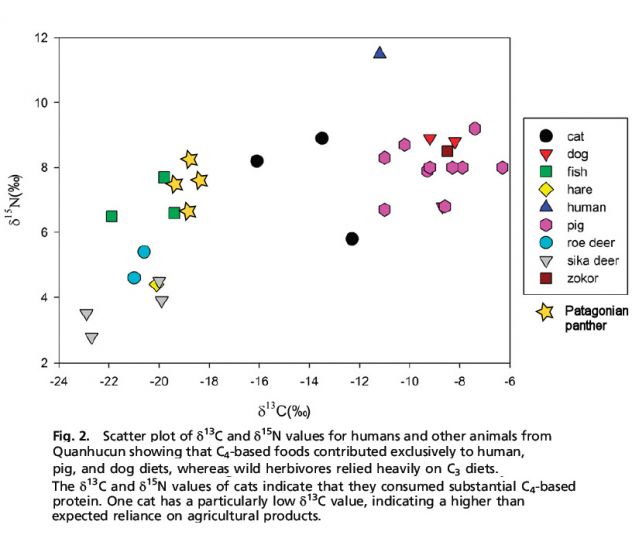Genetics
The Cat's Journey from the Wild
Are bones from a Chinese Neolithic site those of commensal wildcats ?
Posted December 23, 2013
According to the archaeological evidence, the domestic cat seems to have appeared almost fully formed some four to five thousand years ago, in Ancient Egypt. However, the DNA carried by today’s cats indicates a much longer association with mankind, dating back to the transition from hunter-gatherer to settled agriculture, somewhere in the Near East. Yet a scarcity of cat remains from this area, during the five thousand years of transition from wild to domestic, means that the detail of the cat’s initial relationship with humans is still the subject of some speculation. Today’s wildcats are shy, solitary animals that may resemble pet cats in appearance, but they resist all attempts to become socialised to people, so the most plausible route to domestication probably started with a commensal relationship, in which a few especially bold wild cats took up preying on the rodents feeding on mankind’s early stores of grain and other foodstuffs.
A study by Yaowu Hu, Fiona Marshall and colleagues, published last week, shows us a tantalising glimpse of what that process might have been like. Investigating bones from a site in Shaanxi, China from the Yangshao culture, between five and six thousand years ago, they came upon the bones of three small cats: also among the finds were bones of domestic pigs and domestic dogs. In themselves, the cat bones do not provide evidence for domestication - they might have belonged to wild cats trapped for their pelts. However, the team were able to make use of a biochemical peculiarity to investigate the probable diet of each of these animals. The main crop grown at this location was millet, which makes use of an unusual type of photosynthesis, C4 carbon fixation (other food crops that use this include sugar cane, sorghum and maize), while the wild plants growing round about were of the more usual C3 type. Animals that have subsisted mainly on C4 plants leave a different pattern of stable carbon isotopes in their bones (to the right on the graph) to those eating mainly C3 plants (to the left of the graph), so enabling domestic animals to be distinguished from wild, at this location.
Both the dogs and the pigs studied were evidently getting most of their nourishment from the cultivated millet - either directly, or via animal remains or wastes (see the graph below). So too was a single specimen of zokor - a type of bamboo rat - which therefore must have been raiding growing and/or stored millet crops. There was also abundant evidence of rodent burrows leading into grain-storage pits. Thus pest control was probably a serious issue for these people, as also shown by their crop storage vessels, which were designed specifically to prevent rodents from climbing in.

Domestic cats would have undoubtedly been of great assistance, had they existed in that part of the world at that time. A fully domestic cat would have shown a similar carbon ratio to the domestic dogs’: a wild cat hunting wild prey would have a carbon ratio similar to that of the extinct Patagonian panthers measured in another study (superimposed as stars on the graph taken from the Chinese study).
The three cats from China fall halfway between the wild animals (on the left of the graph) and the domestic (on the right), suggesting that they were taking a mixture of prey, partly rodents that had been eating millet, and partly rodents and birds from the wild. This mix suggests a commensal relationship: most likely these were wildcats living close to the settlements, and routinely exploiting the abundance of rodents feeding on the millet. One of the cats, which was older than the others, had an unusually low nitrogen ratio in its bones, and a carbon ratio that approached that of the pigs: this cat may plausibly have become too old to hunt, instead attempting to supplement its diet with millet-based food. It may even have become some kind of pet, fed millet porridge by its “owners”.
This intriguing possibility does, however, leave us with more questions than answers. The first is whether either of the younger cats were also domesticated animals - possibly not, as they were evidently still getting a substantial proportion of their nourishment from wild prey. If they were domesticated, the second question is where such cats might have come from. At that time, domestication in the Near East had not progressed sufficiently far for any cats to have been transported to the opposite side of Asia - conventional accounts have domestic cats first reaching China some three thousand years later.
Indeed, until the DNA in the recovered bones is analysed, we cannot even be sure that they come from the same species as the domestic cat. The DNA of today’s pet cats shows that they are descended exclusively from one subspecies of wildcat, the African/Arabian wildcat Felis silvestris lybica. Another subspecies, F. s. ornata, does occur in northern China, but there is no trace of its DNA in today’s cats, even in the oriental breeds such as the Siamese. The commonest small cat in Shaanxi at that time may well have been the Asian leopard cat Prionailurus bengalensis, which at this point cannot therefore be ruled out as the source of the bones. If these do turn out to have come from leopard cats, then they will provide an intriguing back-story for the modern Bengal breed, which is a recent hybrid between the domestic cat and wild leopard cats.


